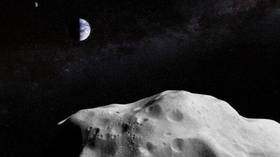Double feature: Not one but TWO asteroids set to fly by Earth this weekend

NASA is brushing off any asteroid alarmism with assurances that Earth is under no immediate danger from incoming space rocks while revealing that two are set to pass our planet safely in the coming days.
Asteroid 2010 C01, measuring roughly 400 to 850 feet (120 to 260 meters) in size, will fly by late on September 13, followed by 2000 QW7 at 950 to 2,100 feet (290 to 650 meters) in the early hours of September 14.
“Both of these asteroids are passing at about 14 lunar distances from the Earth, or about 3.5 million miles away, but small asteroids pass by Earth this close all the time,”said NASA planetary defense officer Lindley Johnson.
“These asteroids have been well observed—once since 2000 and the other since 2010—and their orbits are very well known.”
Also on rt.com All from one? New study suggests comets may have single cosmic source within our solar systemThe two rocks are classified as near-Earth objects (NEOs), though when it comes to distances in space, the word ‘near’ becomes a highly relative term, considering the millions of miles of space between us and them even at their closest point.
2000 QW7 was classified as “unusually bright” when it was first discovered two decades ago, and will come a little bit closer when it passes again in 2038, but still without posing a threat.
Such asteroids are likely remnant debris from the solar system’s formation some 4.6 billion years ago. While rocky asteroids typically form between the orbits of Mars and Jupiter, their icy comet cousins form in the cold outer solar system.
Also on rt.com New interstellar object heading our way, but this time we’re ready for itLike this story? Share it with a friend!













